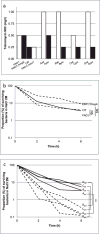Pyomelanin-producing Pseudomonas aeruginosa selected during chronic infections have a large chromosomal deletion which confers resistance to pyocins
- PMID: 27119970
- PMCID: PMC5295658
- DOI: 10.1111/1462-2920.13336
Pyomelanin-producing Pseudomonas aeruginosa selected during chronic infections have a large chromosomal deletion which confers resistance to pyocins
Abstract
When bacterial lineages make the transition from free-living to permanent association with hosts, they can undergo massive gene losses, for which the selective forces within host tissues are unknown. We identified here melanogenic clinical isolates of Pseudomonas aeruginosa with large chromosomal deletions (66 to 270 kbp) and characterized them to investigate how they were selected. When compared with their wild-type parents, melanogenic mutants (i) exhibited a lower fitness in growth conditions found in human tissues, such as hyperosmolarity and presence of aminoglycoside antibiotics, (ii) narrowed their metabolic spectrum with a growth disadvantage with particular carbon sources, including aromatic amino acids and acyclic terpenes, suggesting a reduction of metabolic flexibility. Despite an impaired fitness in rich media, melanogenic mutants can inhibit their wild-type parents and compete with them in coculture. Surprisingly, melanogenic mutants became highly resistant to two intraspecific toxins, the S-pyocins AP41 and S1. Our results suggest that pyocins produced within a population of infecting P. aeruginosa may have selected for bacterial mutants that underwent massive gene losses and that were adapted to the life in diverse bacterial communities in the human host. Intraspecific interactions may therefore be an important factor driving the continuing evolution of pathogens during host infections.
© 2016 Society for Applied Microbiology and John Wiley & Sons Ltd.
Conflict of interest statement
Conflict of interests The authors have declared that no competing interests exist.
Figures





Similar articles
-
Impact of FiuA Outer Membrane Receptor Polymorphism on the Resistance of Pseudomonas aeruginosa toward Peptidoglycan Lipid II-Targeting PaeM Pyocins.J Bacteriol. 2019 Jun 10;201(13):e00164-19. doi: 10.1128/JB.00164-19. Print 2019 Jul 1. J Bacteriol. 2019. PMID: 30988031 Free PMC article.
-
A predicted immunity protein confers resistance to pyocin S5 in a sensitive strain of Pseudomonas aeruginosa.Chembiochem. 2013 Dec 16;14(18):2444-6. doi: 10.1002/cbic.201300410. Epub 2013 Nov 12. Chembiochem. 2013. PMID: 24222552 No abstract available.
-
Pyocins and Beyond: Exploring the World of Bacteriocins in Pseudomonas aeruginosa.Probiotics Antimicrob Proteins. 2025 Feb;17(1):240-252. doi: 10.1007/s12602-024-10322-3. Epub 2024 Jul 18. Probiotics Antimicrob Proteins. 2025. PMID: 39023701 Review.
-
A Colicin M-Type Bacteriocin from Pseudomonas aeruginosa Targeting the HxuC Heme Receptor Requires a Novel Immunity Partner.Appl Environ Microbiol. 2018 Aug 31;84(18):e00716-18. doi: 10.1128/AEM.00716-18. Print 2018 Sep 15. Appl Environ Microbiol. 2018. PMID: 29980560 Free PMC article.
-
Pseudomonas aeruginosa chromosomal beta-lactamase in patients with cystic fibrosis and chronic lung infection. Mechanism of antibiotic resistance and target of the humoral immune response.APMIS Suppl. 2003;(116):1-47. APMIS Suppl. 2003. PMID: 14692154 Review.
Cited by
-
Pyomelanin-Producing Brevundimonas vitisensis sp. nov., Isolated From Grape (Vitis vinifera L.).Front Microbiol. 2021 Oct 14;12:733612. doi: 10.3389/fmicb.2021.733612. eCollection 2021. Front Microbiol. 2021. PMID: 34721332 Free PMC article.
-
History of antibiotic adaptation influences microbial evolutionary dynamics during subsequent treatment.PLoS Biol. 2017 Aug 8;15(8):e2001586. doi: 10.1371/journal.pbio.2001586. eCollection 2017 Aug. PLoS Biol. 2017. PMID: 28792497 Free PMC article.
-
Within-Host Microevolution of Pseudomonas aeruginosa Urinary Isolates: A Seven-Patient Longitudinal Genomic and Phenotypic Study.Front Microbiol. 2021 Jan 14;11:611246. doi: 10.3389/fmicb.2020.611246. eCollection 2020. Front Microbiol. 2021. PMID: 33519766 Free PMC article.
-
Pseudomonas aeruginosa MutL promotes large chromosomal deletions through non-homologous end joining to prevent bacteriophage predation.Nucleic Acids Res. 2018 May 18;46(9):4505-4514. doi: 10.1093/nar/gky160. Nucleic Acids Res. 2018. PMID: 29514250 Free PMC article.
-
Characterization of 2-(2-nitro-4-trifluoromethylbenzoyl)-1,3-cyclohexanedione resistance in pyomelanogenic Pseudomonas aeruginosa DKN343.PLoS One. 2017 Jun 1;12(6):e0178084. doi: 10.1371/journal.pone.0178084. eCollection 2017. PLoS One. 2017. PMID: 28570601 Free PMC article.
References
-
- Beloin C, Valle J, Latour-Lambert P, Faure P, Kzreminski M, Balestrino D, et al. Global impact of mature biofilm lifestyle on Escherichia coli K-12 gene expression. Mol Microbiol. 2004;51:659–674. - PubMed
-
- Bentley SD, Parkhill J. Comparative genomic structure of prokaryotes. Annu Rev Genet. 2004;38:771–791. - PubMed
MeSH terms
Substances
Grants and funding
LinkOut - more resources
Full Text Sources
Other Literature Sources
Medical

